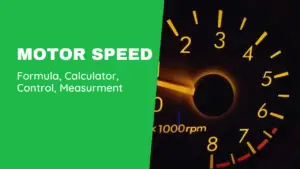Have you ever wondered why a 3-phase motor might draw high amps? Excessive amp draw can be a sign of several electrical or mechanical issues.
In this article, we’ll explore the most common causes of high amp draw in 3-phase motors, including voltage imbalance, overloading, damaged bearings, and more.
We’ll also provide in-depth explanations of each issue and offer practical solutions for resolving them.
Table of Contents
Causes of High Amp Draw in 3-Phase Motors:
Electrical Issues:
Voltage Imbalance:
One of the most common causes of high amp draw in 3-phase motors is voltage imbalance. Voltage imbalance occurs when the three phases of a motor receive different voltage levels.
This can happen due to issues with the power supply or wiring. If left unchecked, voltage imbalance can cause a host of problems, including increased heat, reduced efficiency, and premature motor failure.
To fix voltage imbalance, it’s essential to identify the source of the problem and make necessary repairs.
- Overvoltage or Undervoltage:
Overvoltage or undervoltage can also cause a 3-phase motor to draw high amps. Overvoltage occurs when the voltage level supplied to the motor is higher than its rated voltage, while undervoltage occurs when the voltage level is lower than the rated voltage.
Both issues can cause the motor to work harder and draw more amps than it should. To prevent overvoltage or undervoltage, it’s crucial to use the correct voltage level for the motor and perform regular maintenance to ensure that the power supply is working correctly.
- Shorted Windings:
Shorted windings can also lead to high amp draw in 3-phase motors. Shorted windings occur when the insulation on the motor’s windings breaks down, causing a short circuit.
When this happens, the motor may draw more amps than usual to compensate for the damaged windings.
Shorted windings can be challenging to diagnose and fix, but it’s essential to address the issue promptly to prevent further damage to the motor.
- Excessive Load:
Finally, excessive load can cause a 3-phase motor to draw high amps. If the motor is working beyond its rated capacity, it may draw more amps than usual to keep up with the demand.
This can cause the motor to overheat, reduce efficiency, and ultimately fail. To prevent excessive load, it’s crucial to ensure that the motor is appropriately sized for the job and not overloaded.
Mechanical Issues:
Overloading:
Overloading is a common mechanical issue that can cause a 3-phase motor to draw high amps.
Overloading occurs when the motor is forced to work beyond its rated capacity, causing it to draw more amps than it should.
Overloading can lead to increased heat, reduced efficiency, and premature motor failure. To prevent overloading, it’s crucial to ensure that the motor is appropriately sized for the job and not subjected to excessive load.
Damaged Bearings:
Damaged bearings can also cause a 3-phase motor to draw high amps. Bearings help support the motor’s rotating shaft, allowing it to turn smoothly.
When bearings are damaged, the motor may have to work harder to compensate, causing it to draw more amps than it should.
To prevent damaged bearings, it’s essential to perform regular maintenance, including lubrication and inspection.
Misalignment:
Finally, misalignment can cause a 3-phase motor to draw high amps. Misalignment occurs when the motor’s shaft and the driven equipment are not aligned correctly.
This can cause the motor to work harder than it should, leading to increased amp draw, heat, and reduced efficiency.
To prevent misalignment, it’s crucial to ensure that the motor’s shaft and the driven equipment are aligned correctly and to perform regular maintenance to ensure that everything is in working order.
Practical Solutions:
Now that we’ve discussed the most common causes of high amp draw in 3-phase motors, let’s take a look at some practical solutions for addressing these issues.
Voltage Imbalance:
To address voltage imbalance, it’s essential to identify the source of the problem. This may involve checking the power supply, the wiring, and the motor’s connections.
Once the issue has been identified, it’s crucial to make the necessary repairs to ensure that the voltage is balanced across all three phases of the motor.
Overvoltage or Undervoltage:
To prevent overvoltage or undervoltage, it’s essential to use the correct voltage level for the motor and to perform regular maintenance to ensure that the power supply is working correctly.
This may involve installing voltage regulators or other protective devices to prevent voltage fluctuations from damaging the motor.
Shorted Windings:
Shorted windings can be challenging to diagnose and fix, but it’s essential to address the issue promptly to prevent further damage to the motor.
This may involve replacing the damaged windings or rewinding the motor entirely. It’s crucial to work with a qualified electrician or motor repair specialist to ensure that the repairs are done correctly.
Excessive Load:
To prevent excessive load, it’s crucial to ensure that the motor is appropriately sized for the job and not overloaded.
This may involve installing additional motors or using different equipment to distribute the load more evenly.
It’s essential to consult with a qualified engineer or motor specialist to ensure that the motor is being used correctly and safely.
Damaged Bearings:
To prevent damaged bearings, it’s essential to perform regular maintenance, including lubrication and inspection.
This may involve replacing worn or damaged bearings, as well as ensuring that the motor is properly aligned and balanced.
Misalignment:
To prevent misalignment, it’s crucial to ensure that the motor’s shaft and the driven equipment are aligned correctly and to perform regular maintenance to ensure that everything is in working order.
This may involve using alignment tools or consulting with a qualified engineer or motor specialist to ensure that everything is in working order.
Conclusion:
In conclusion, high amp draw in 3-phase motors can be caused by a variety of issues, both electrical and mechanical.
It’s essential to address these issues promptly to prevent further damage to the motor and to ensure that it is operating safely and efficiently.
By performing regular maintenance, identifying and addressing potential issues, and consulting with qualified experts when necessary, you can keep your 3-phase motor running smoothly and reliably for years to come.
Don’t Leave Empty-Handed!
Install my Free Android App on Google Play:
Electrical Cables Most Common Tables “Cables Tables”
And, my Electrical Calculations App “Fast Electrical Calculator”
Discover more great content by subscribing to My channel
Looking to stay ahead of the game in the world of electrical engineering? Subscribe to my YouTube channel and gain access to exclusive content you won’t find anywhere else!
The staff I recommend
(Amazon Affiliate Links to products I believe are high quality):
- Economy 120 Volt/60Hz AC Power Source – Step-Down Voltage & Frequency Converters 1800W
- UNI-T Digital Multimeter Tester UT139C
- 50-Amp Extension Cord for RV “100ft”
- Voltage Stabilizer 110/220v
- Hair Dryer “best selling“
- TOSHIBA EM131A5C-BS Countertop Microwave Ovens
Disclaimer: This contains affiliate links to Amazon products. I may earn a commission for purchases made through these links.


